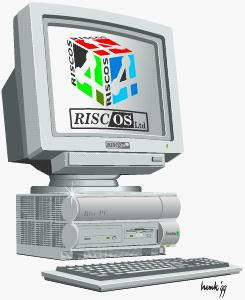Risc PC
|
|
The Risc PC (codenamed Medusa) was Acorn Computers Ltd's next generation RISC OS/Acorn RISC Machine computer, launched in 1994, which superseded the Acorn Archimedes.
Like the Archimedes, the Risc PC continued the practice of having the RISC OS operating system in a ROM module. RiscPC augmented the ROM-based core OS with a disk-based directory structure containing configuration information, and some applications which had previously been kept in ROM.
| Contents [hide] |
Specifications and technical details
- Memory type: SIMM, 2 slots, supporting a maximum memory size of 256 MB.
- Video subsystem: VIDC20 controller, with optional dual-port VRAM up to 2 MB.
- Expansion: Eurocard-sized Podule support in common with Archimedes-series machines. The RiscPC also offers DMA support in the first two podules on the bus.
- Operating System: RISC OS 3.5 (RiscPC 600), RISC OS 3.6 (RiscPC 700), RISC OS 3.7 (StrongARM RiscPC). RISC OS 4 is available as a replacement for the Acorn-implemented versions which came fitted as standard.
- Case: Designed by industrial designer Allen Boothroyd of Cambridge Product Design (designer of the BBC Micro case). Custom plastic-based design with a novel 'slice' feature which allows extra case modules to be added to increase internal expansion space. Each slice adds 2 podule bays at the rear, and two drive bays (one 3.5 inch, one 5.25 inch) at the front, covered by a retractable flap to hide cosmetic inconsistencies in hue. The inside of the case is metal-sprayed to meet electromagnetic and radio emissions regulations.
- Ports: Serial, Parallel, PS/2 keyboard, Acorn mouse, headphone audio out, HD15 VGA, network (optional).
- CPU: Dual-processor slots, accepting the following chips on a special daughterboard: ARM6 at 30 MHz or 33 MHz, ARM7 at 40 MHz, StrongARM at 203 MHz, 233 MHz or 300 MHz+. 486 and 586-based co-processors at up to 133 MHz, and DSP chips (third party) were also available.
Milestones
1994 - RiscPC 600 launched, featuring a 30 MHz ARM6 CPU.
1995 - ARM7 CPU upgrade and RiscPC 700 model launched.
1996 - StrongARM CPU upgrade released, offering a fivefold increase in raw processing power compared to the ARM7 used in the previous high-end machines.
2001 - Viewfinder PCI to Podule adapter allows the use of PC graphics cards.
RiscPC 2
Acorn set about designing the Risc PC 2 - a design with a 64 MHz front side bus, PCI slots, and a yellow-coloured NLX form-factor case. Slated for release in late 1998, the project was canned just before completion. Only two prototypes were ever built, and were shown at the RISC OS 2001 show in Berkshire, England; the remaining cases were sold off as collector's items, without the computer itself.
RiscPC today
Variants of the Risc PC design are still sold today, but Risc PCs have reached the end of their production cycle with the advent of RISC OS computers based around the XScale ARM processor and PCI bus (namely the Iyonix PC). Second-hand Risc PCs command very high prices relative to PCs of similar age and specifications. Significantly better performance has been pulled out of the aged Risc PC design by using the newer 202 (and later 233) MHz StrongARM CPU, using third-party video cards, overclocking, and having specially-designed CPU cards with RAM located upon them to sidestep the speed bottleneck of the slow system bus.
Limitations
The front side bus is usually recognised as being the most significant fault of the computer; and the arrival of the (five times faster) StrongARM processor in 1996 meant that the Risc PC had a CPU vastly faster than that for which the computer had been designed. Acorn had originally expected ARM CPUs to progress from the 30 MHz ARM6 to the 40 MHz ARM7, and then onto the ARM8 cores, which at the time were clocked at around 50-80 MHz.
See also
- BBC Micro ancestor.
- Acorn Archimedes direct predecessor
- Acorn Computers Ltd
- RISC OS
External links
- Castle reveal Kinetic Risc PC to the press (http://www.iconbar.com/hardware/kinetic/)
- Risc PC 10th Birthday (http://www.iconbar.com/Happy_10th_Birthday_Risc_PC/news430.html)
- Risc PC production ceases (http://www.iconbar.com/R.I.P.__RiscPC/news374.html)
- Castle bids farewell to Risc PC (http://www.drobe.co.uk/riscos/artifact869.html)
| List of Acorn Computers microcomputers |
|
Microcomputer System | Atom | BBC Micro (aka Proton) | Electron | Communicator | Business Computer | BBC Master | Archimedes range | RISC PC | Network Computer | Set-Top Box | Phoebe |

